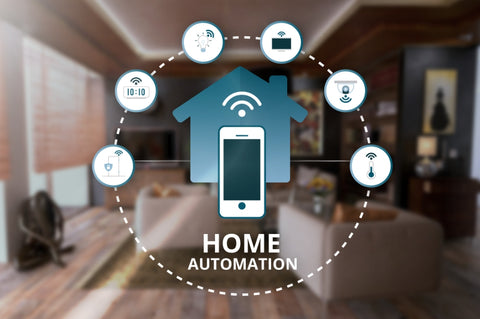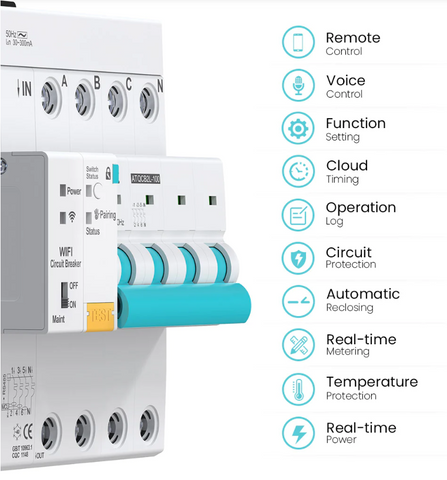Intelligence into Power Distribution: The Rise of Smart Circuit Breaker Solutions

Enter the era of smart circuit breaker solutions—an innovative leap forward in the field of power distribution. These intelligent devices represent a convergence of cutting-edge technologies, offering a dynamic approach to managing and controlling electrical circuits. Smart circuit breakers have real-time monitoring, data analytics, and connectivity. They make power distribution safer, more efficient, and adaptable to modern energy landscapes.
I. What You Need to Know about Smart Circuit Breakers
A. Definition and Basic Functionality
Smart circuit breakers are advanced electronic devices designed to go beyond the basic functions of their traditional counterparts. These devices not only interrupt electrical currents during faults but also incorporate sophisticated technologies to provide real-time monitoring, remote control, and analysis of data. This added intelligence allows for more precise and efficient management of electrical circuits.
B. Differentiating Factors from Traditional Circuit Breakers
What sets smart circuit breakers apart from their traditional counterparts are their enhanced capabilities. Unlike conventional circuit breakers, smart variants can actively communicate with other devices and systems, enabling seamless integration into larger smart grids. The`y can collect and analyze data instantly, making them proactive parts of a smarter and more responsive power grid.
C. Role in Enhancing Power Distribution Efficiency and Safety
Smart circuit breakers play a pivotal role in enhancing the overall efficiency and safety of power distribution. Through their intelligent features, they can identify potential issues before they escalate, allowing for predictive maintenance and minimizing downtime. By monitoring and controlling electrical circuits remotely, they can enhance the flexibility and safety of the power distribution system. This is achieved by reducing the risk of failures.
II. Benefits of Integrating Intelligence into Power Distribution
A. Improved Reliability and Reduced Downtime
One of the primary benefits of integrating intelligence into power distribution through smart circuit breakers is the substantial improvement in system reliability. These devices can find and fix problems early, which means less time when things aren't working. By preemptively identifying faults or overloads and taking swift corrective actions, smart circuit breakers contribute to a more reliable and resilient power distribution infrastructure.
B. Increased Energy Efficiency and Cost Savings
Smart circuit breakers, equipped with real-time data analytics capabilities, play a pivotal role in optimizing energy usage. The ability to monitor and analyze electrical consumption patterns allows for more efficient distribution and utilization of power. This saves energy and money for utility providers and end-users by reducing wastage and costs. The integration of intelligence enables a more precise and economical management of power resources.
C. Enhanced Safety Features for Both Equipment and Personnel
The incorporation of intelligence into power distribution enhances safety across the board. Smart circuit breakers can identify potential hazards, such as electrical faults or anomalies, and take immediate corrective actions. This not only protects the equipment from damage but also mitigates risks to personnel. The improved safety features contribute to a secure operational environment, reducing the likelihood of accidents and ensuring the longevity of the power distribution infrastructure.
D. Contribution to the Development of Smart Grids
Smart circuit breakers are integral components in the evolution of smart grids. These grids leverage advanced communication and control technologies to enhance the efficiency and reliability of power distribution. By actively participating in the two-way flow of information within smart grids, intelligent circuit breakers contribute to the overall intelligence of the network. Teamwork helps distribute work evenly. It also helps find problems and combine renewable energy sources. This ultimately leads to a more sustainable and adaptable energy system.
III. Case Studies
A. Highlighting Successful Implementations of Smart Circuit Breaker Solutions
1. Urban Smart Grid Integration
- Context: The implementation of smart circuit breakers in an urban setting to enhance the reliability of the power grid and accommodate the growing demand for energy in a densely populated area.
- Results: Reduced downtime during peak demand, improved fault detection, and optimized energy distribution.
2. Industrial Complex Optimization
- Context: Integration of intelligent power distribution systems in an industrial complex to improve energy efficiency and streamline maintenance processes.
- Results: Significant reduction in energy consumption, enhanced predictive maintenance, and improved safety for on-site personnel.
B. Demonstrating Tangible Benefits and Results
1. Energy Cost Reduction in Commercial Buildings
- Context: Deployment of smart circuit breakers to optimize energy consumption in commercial buildings, aiming for cost savings.
- Results: Achieved a 15% reduction in energy costs, with real-time analytics identifying and rectifying inefficiencies in power usage.
2. Grid Resilience in Extreme Weather Events
- Location: Coastal Region
- Context: Implementation of intelligent power distribution for resilience against extreme weather conditions, such as hurricanes and storms.
- Results: Minimal power outages during severe weather events, showcasing the adaptability and responsiveness of smart circuit breakers.
C. Lessons Learned from Real-World Applications

1. Cybersecurity Measures in Utility Grids
- Insight: Lessons learned from a utility company's deployment of smart circuit breakers, emphasizing the importance of robust cybersecurity measures.
- Key Takeaway: The integration of intelligence requires a comprehensive cybersecurity strategy to safeguard against potential cyber threats and unauthorized access.
2. Adapting to Legacy Systems
- Insight: Experience from a project involving the retrofitting of smart circuit breakers into an existing power distribution infrastructure.
- Key Takeaway: Compatibility with legacy systems is a crucial consideration; understanding and addressing interoperability challenges are essential for successful integration.
3. Community Engagement for Grid Enhancement
- Insight: A case study focusing on a utility company's approach to community engagement during the implementation of intelligent power distribution.
- Key Takeaway: Involving the community in the process and addressing concerns helps build acceptance and fosters a positive perception of the technology.
These examples show how smart circuit breaker solutions have many different uses and practical advantages. Intelligent power distribution is used in cities and industries to improve efficiency, safety, and adaptability. It works well in different situations and is resilient.
IV. Conclusion
Integrating intelligence into power distribution with smart circuit breakers is crucial for navigating our interconnected world. The blog explained how this technology can shape the future of electricity management by revealing its potential. Smart circuit breakers are important for a better energy future. They improve safety, efficiency, and adaptability in power distribution electrical systems.
Contact:
sale@at-ele.com




